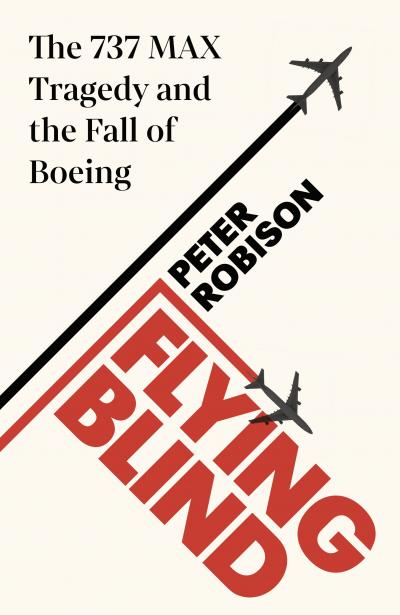Peter Robison: Flying Blind review – a story of decline and crawl | reviews, news & interviews
Peter Robison: Flying Blind review – a story of decline and crawl
Peter Robison: Flying Blind review – a story of decline and crawl
The galling account of the 737 MAX Boeing tragedies

Thomas Pynchon’s saturnine '70s novel Gravity’s Rainbow (1973) begins with “[a] screaming [that] comes across the sky. It has happened before, but there is nothing to compare it to now.” In contrast, on 10 March 2019, when a Boeing 737 MAX operated by Ethiopian Airlines took off from Addis Abada and, six minutes later, plunged into a field near the town of Bishoftu and killed 157 people, there very much was something to compare it to.
Two catastrophic crashes in quick succession. How did this happen? The short answer is: a fatal combination of complacency, deregulation and cost-cutting. As Peter Robison notes in Flying Blind: The 737 MAX Tragedy and the Fall of Boeing, his clear-eyed, anger-inducing account of these avoidable tragedies, “[w]hat happened at Boeing reflects the same forces that have roiled corporate America since the Reagan revolution”, fostering a culture in thrall to voodoo economists like Milton Friedman, with his snickering admonition that “the social responsibility of business is to increase its profits''.
Robison, an award-winning investigative reporter for Bloomberg News, laments the “anti-union, regulation-light, outsourcing-heavy” culture that enabled the Boeing tragedies. Against a background of “tax breaks and lucrative government contracts'', Boeing remodelled an existing, outdated plane, the 737, instead of investing in a new aeroplane, while they splurged on shareholder-enriching stock buybacks. They skimped on various aspects, including software called MCAS, which they deliberately concealed from airlines, meaning that a single point of failure could, and duly did, see the MCAS insisting that the plane’s nose needed to be pointed sharply down, when in fact the opposite was true.
Boeing’s story is long, its cast of characters large, and inevitably, despite Robison’s skill in providing concise potted biographies, many become the dramatis personae equivalent of flyover country. Some do stand out, though. Early on, it’s old-schoolers like Joe Sutter, who came to Boeing having served on a US Navy destroyer during the Second World War, and led Boeing’s illustrious 747 programme. On being upbraided because “your engineers are spending five million dollars a day”, he said they’d be doing a better job and saving Boeing money if they spent six million per day. Following Boeing’s ill-advised merger with McDonnell Douglas, it’s ghouls like Harry Stonecipher, a man with “a mien you’d call Trumpian if such a thing had existed then: a kind of deep-seated need for alpha displays, public humiliation, and conflict”. Replacing the old Boeing motto of “Working Together” with “More for Less”, the new regime reduced Boeing to “a collection of assets to be shuffled as managers saw fit to make the most beneficial combination for stockholders, not for customers or employees''.
 Robison has a keen eye for detail, and for tracking the destructive influence wielded by some of Boeing’s more egregious executives. Denis Muilenburg, CEO at the time of the MAX disasters, enjoyed quoting scripture and publicising his piousness, but still cosied up to Donald Trump. Documenting his obsession with challenging Boeing employees to bicycle races, Robison wryly notes that “corporate hubris often reveals itself through extreme sports.”.
Robison has a keen eye for detail, and for tracking the destructive influence wielded by some of Boeing’s more egregious executives. Denis Muilenburg, CEO at the time of the MAX disasters, enjoyed quoting scripture and publicising his piousness, but still cosied up to Donald Trump. Documenting his obsession with challenging Boeing employees to bicycle races, Robison wryly notes that “corporate hubris often reveals itself through extreme sports.”.
To protect Boeing in the aftermath of the crashes, Muilenburg orchestrated a campaign of lies and sophistry, including intimidation and gaslighting of the victims’ families. He covered up concerns from internal whistleblowers, insisting that the MAX was safe. Meanwhile, a craven FAA, emasculated by decades of deregulation, failed to ground the faulty plane in the US. Action was only taken, reluctantly, after the second MAX crashed and a further 157 people had died.
All of this is tinged with a sickening whiff of racism, and Robison takes time to call this out while documenting the victims’ stories and perspectives. Amid the stupefying cynicism and ass-covering in which Boeing indulged, and the devaluation of human life, one of the lawyers acting on the behalf of relatives concluded: “The underbelly of aviation is the disenfranchisement of people of colour globally.” The foreign locations of the two crashes meant Boeing’s victim-blaming narrative was readily swallowed by swathes of the media: the tenor of the times made it easy to pin the blame on black and brown people from the places Muilenburg’s buddy Trump labelled “shithole countries”.
Robison casts a cold eye on the callousness of the Boeing executives. He doesn’t pull any punches in his descriptions of their personal demeanors, or what this says about their underlying lack of humanity. After the FAA finally grounded the MAX, Boeing’s leadership were called before a Senate hearing in Washington. Muilenburg, writes Robison, continued to prevaricate haughtily; Tim Keating, Boeing’s government operations chief and another assiduous Trump suck-up, chewed gum while maintaining a facial expression “suggesting he was watching an especially interesting movie”.
The MAX scandal, together with the 95% drop in air traffic because of Covid, should’ve finished Boeing off. But in “the dark calculus of twenty-first-century corporate management, a global tragedy was also an opportunity”. Instead of “a corporate pariah whose mismanagement had contributed to a catastrophic loss of life”, Robison writes, Boeing became “an endangered American manufacturer working to secure the livelihoods of tens of thousands of employees”. Having had to “draw down a $13.8 billion bank loan just to keep operations running” and on the verge of needing a federal bailout, a combination of private equity and Covid aid, plus some juicy military contracts, kept the company from collapse.
Towards the end of Gravity’s Rainbow, Pynchon – who worked briefly for Boeing in the 1960s – advises readers speculating on the whereabouts of his arch-villain, the rocket-fetishising SS Captain Blicero: “If you’re wondering where he has gone, look among the successful academics, the presidential advisers, the token intellectuals who sit on boards of directors. He is almost certainly there. Look high, not low.” In his epilogue, Robison documents the preposterously monied fates of his cast of grotesques, with their colossal retirement funds, pampered lives, and bling-encrusted mansions. They, and Boeing, “got away with it”. The flawed MAX still flies. The company limps on, posting huge quarterly losses but using financial chicanery to ‘pull money forward’ by delaying supplier payments whilst booking advance sales income: the corporate equivalent of a family living way beyond their means.
As a business reporter publishing his debut book, Robison should be saluted for tackling this sorry tale in such an honest, straight-dealing manner; if Boeing had behaved with such integrity, a lot fewer people might have died. His important, elegantly written but ultimately depressing book documents the “blossoming and fruition” of the seeds planted by Reagan's administration and the cult of deregulation decades ago, the 346 innocent victims of Boeing’s “death jet” sacrifices to the chimera of infinite financial ‘growth’. It’s a metaphor for where we all are today: trending downward; racking up debts; overreaching ourselves; failing to learn from mistakes; riding for a fall. Like Boeing, we are down but not out. You might call it a story of ‘decline and crawl’.
- Flying Blind: The 737 MAX Tragedy and the Fall of Boeing by Peter Robison (Penguin Business, £20.00)
- Read more book reviews and features on theartsdesk
The future of Arts Journalism
You can stop theartsdesk.com closing!
We urgently need financing to survive. Our fundraising drive has thus far raised £49,000 but we need to reach £100,000 or we will be forced to close. Please contribute here: https://gofund.me/c3f6033d
And if you can forward this information to anyone who might assist, we’d be grateful.

Subscribe to theartsdesk.com
Thank you for continuing to read our work on theartsdesk.com. For unlimited access to every article in its entirety, including our archive of more than 15,000 pieces, we're asking for £5 per month or £40 per year. We feel it's a very good deal, and hope you do too.
To take a subscription now simply click here.
And if you're looking for that extra gift for a friend or family member, why not treat them to a theartsdesk.com gift subscription?
more Books
 'We are bowled over!' Thank you for your messages of love and support
Much-appreciated words of commendation from readers and the cultural community
'We are bowled over!' Thank you for your messages of love and support
Much-appreciated words of commendation from readers and the cultural community
 Thomas Pynchon - Shadow Ticket review - pulp diction
Thomas Pynchon's latest (and possibly last) book is fun - for a while
Thomas Pynchon - Shadow Ticket review - pulp diction
Thomas Pynchon's latest (and possibly last) book is fun - for a while
 Justin Lewis: Into the Groove review - fun and fact-filled trip through Eighties pop
Month by month journey through a decade gives insights into ordinary people’s lives
Justin Lewis: Into the Groove review - fun and fact-filled trip through Eighties pop
Month by month journey through a decade gives insights into ordinary people’s lives
 Joanna Pocock: Greyhound review - on the road again
A writer retraces her steps to furrow a deeper path through modern America
Joanna Pocock: Greyhound review - on the road again
A writer retraces her steps to furrow a deeper path through modern America
 Mark Hussey: Mrs Dalloway - Biography of a Novel review - echoes across crises
On the centenary of the work's publication an insightful book shows its prescience
Mark Hussey: Mrs Dalloway - Biography of a Novel review - echoes across crises
On the centenary of the work's publication an insightful book shows its prescience
 Frances Wilson: Electric Spark - The Enigma of Muriel Spark review - the matter of fact
Frances Wilson employs her full artistic power to keep pace with Spark’s fantastic and fugitive life
Frances Wilson: Electric Spark - The Enigma of Muriel Spark review - the matter of fact
Frances Wilson employs her full artistic power to keep pace with Spark’s fantastic and fugitive life
 Elizabeth Alker: Everything We Do is Music review - Prokofiev goes pop
A compelling journey into a surprising musical kinship
Elizabeth Alker: Everything We Do is Music review - Prokofiev goes pop
A compelling journey into a surprising musical kinship
 Natalia Ginzburg: The City and the House review - a dying art
Dick Davis renders this analogue love-letter in polyphonic English
Natalia Ginzburg: The City and the House review - a dying art
Dick Davis renders this analogue love-letter in polyphonic English
 Tom Raworth: Cancer review - truthfulness
A 'lost' book reconfirms Raworth’s legacy as one of the great lyric poets
Tom Raworth: Cancer review - truthfulness
A 'lost' book reconfirms Raworth’s legacy as one of the great lyric poets
 Ian Leslie: John and Paul - A Love Story in Songs review - help!
Ian Leslie loses himself in amateur psychology, and fatally misreads The Beatles
Ian Leslie: John and Paul - A Love Story in Songs review - help!
Ian Leslie loses himself in amateur psychology, and fatally misreads The Beatles
 Samuel Arbesman: The Magic of Code review - the spark ages
A wide-eyed take on our digital world can’t quite dispel the dangers
Samuel Arbesman: The Magic of Code review - the spark ages
A wide-eyed take on our digital world can’t quite dispel the dangers
 Zsuzsanna Gahse: Mountainish review - seeking refuge
Notes on danger and dialogue in the shadow of the Swiss Alps
Zsuzsanna Gahse: Mountainish review - seeking refuge
Notes on danger and dialogue in the shadow of the Swiss Alps

Add comment